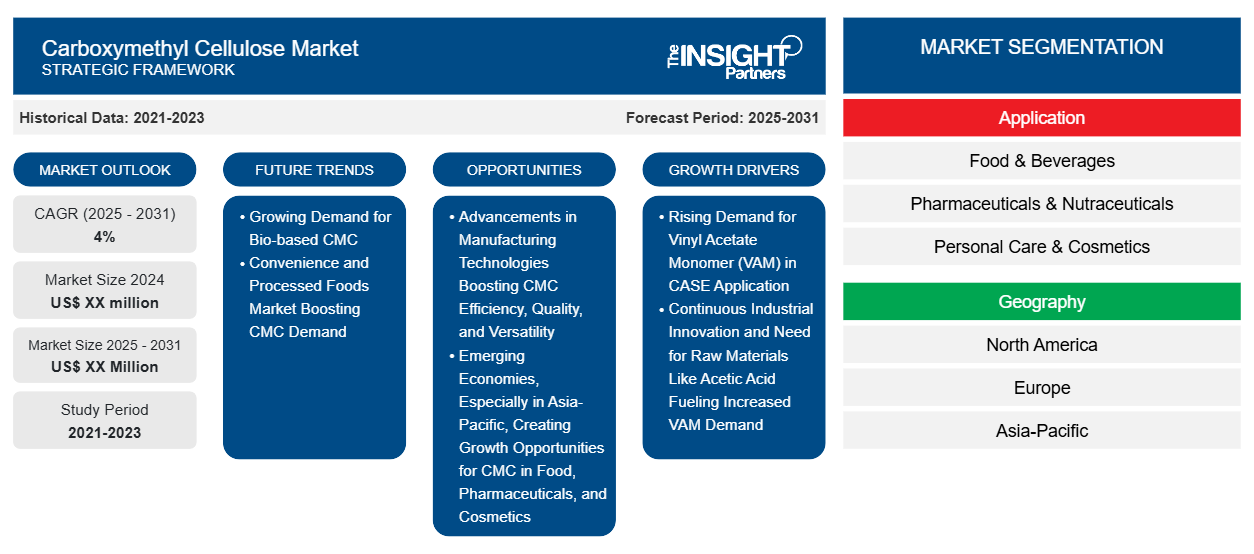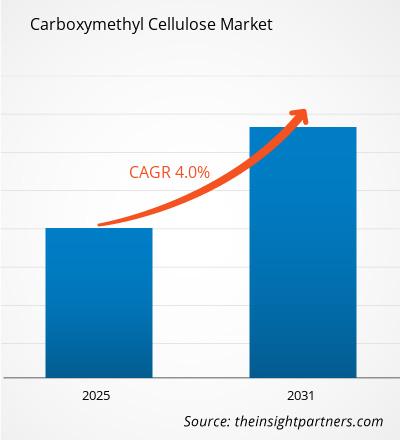The carboxymethyl cellulose market size is projected to reach US$ 2.3 billion by 2031 from US$ 1.7 billion in 2023. The market is expected to register a CAGR of 4% during 2023–2031. Rising demand for clean label ingredients and inclination toward using carboxymethyl cellulose (CMC) in an eco-friendly packaging solution are likely to remain key trends in the carboxymethyl cellulose market.
Carboxymethyl Cellulose Market Analysis
The rising demand for carboxymethyl cellulose from the pharmaceutical industry due to its stabilizing and binding properties drives the carboxymethyl cellulose market growth. Carboxymethyl cellulose (CMC) is a valuable ingredient in various pharmaceutical applications:
- CMC acts as a binder in tablet formulations, which helps hold all the ingredients together. It also acts as a disintegrant, aiding in the tablet's breakdown for efficient drug release.
- CMC is used in various pharmaceutical formulations as a viscosity modifier, enhancing the stability and ease of administration, especially in suspensions and syrups.
- Carboxymethyl cellulose stabilizes the emulsions and suspensions, ensuring that the pharmaceutical formulations remain well-dispersed and uniform.
- In some drug delivery systems, CMC is used to control the release of active pharmaceutical ingredients (APIs), providing a sustained and controlled release of optimal therapeutic effects.
- It is used in eye drops and ointments as a viscosity modifier and stabilizer, improving the retention of the product on the ocular surface.
- In wound care products, CMC contributes to the formation of gels and ointments, aiding the protection and healing of wounds.
- CMC can also be used to enhance the bioavailability of poorly water-soluble drugs by improving their solubility and dissolution rate.
- It is GRAS-approved (i.e., Generally Recognized as Safe) by the Food and Drug Administration (FDA), making it suitable for pharmaceuticals without any significant safety concerns.
Thus, the wide range of applications of carboxymethyl cellulose (CMC) in the pharmaceutical industry drives its demand.
Carboxymethyl Cellulose Market Overview
Carboxymethyl cellulose is a cellulose derivative with a carboxymethyl group bound to one of the hydroxyl groups of the cellulose polymer. It is commonly used in pharmaceuticals, food & beverages, cosmetics, and other industries due to its excellent stabilizing, thickening, and emulsifying properties. In the food & beverages industry, carboxymethyl cellulose acts as an effective thickening agent, enhancing the texture and viscosity of various food products such as dressings, sauces, dips, and beverages. It helps stabilize the emulsions that prevent the separation of ingredients in products such as ice creams, salad dressings, and frozen desserts. In addition, carboxymethyl cellulose has water retention properties that help prevent the formation of ice crystals in ice creams and frozen desserts and improve moisture retention in bakery products. Therefore, the numerous benefits of carboxymethyl cellulose in food and beverage formulations propel its demand in the industry, which bolsters the carboxymethyl cellulose market growth.
Customize This Report To Suit Your Requirement
You will get customization on any report - free of charge - including parts of this report, or country-level analysis, Excel Data pack, as well as avail great offers and discounts for start-ups & universities
Carboxymethyl Cellulose Market: Strategic Insights

-
Get Top Key Market Trends of this report.This FREE sample will include data analysis, ranging from market trends to estimates and forecasts.
Carboxymethyl Cellulose Market Drivers and Opportunities
Various Strategies Adopted by Key Market Players
Market players adopt various strategies such as mergers & acquisitions, partnerships, collaborations, new product developments, and plant capacity expansions to stay ahead of the competition and increase their carboxymethyl cellulose market share. In July 2021, Nouryon completed the acquisition of J.M. Huber Corp’s carboxymethyl cellulose (CMC) business. The acquisition will help Nouryon to broaden its CMC product portfolio, which will help cater to a broader customer base across various geographies. Manufacturers are also expanding their manufacturing base across emerging economies to widen their customer reach and increase their market share in the carboxymethyl cellulose market. In February 2023, Nippon Paper Industries Co Ltd announced the establishment of a carboxymethyl cellulose manufacturing facility in Hungary, which is one of the popular materials used in lithium-ion batteries of electric vehicles. The expansion of its manufacturing and sales facility in Hungary will help the company strengthen its rapidly growing supply chain in Europe. Such strategies propel the carboxymethyl cellulose market growth.
Rising Focus on Sustainability to Provide Massive Opportunities
There is a trend toward using carboxymethyl cellulose (CMC) in an eco-friendly packaging solution with a growing emphasis on sustainability. CMC is biodegradable, which aligns with the increasing awareness of environmental sustainability. People are increasingly adopting products with biodegradable and eco-friendly packaging to reduce the environmental impact of conventional, fossil fuel-based packaging materials. This factor provides new opportunities for the carboxymethyl cellulose market development over the forecast period.
Carboxymethyl Cellulose Market Report Segmentation Analysis
Key segments that contributed to the derivation of the carboxymethyl cellulose market analysis are application and geography.
- Based on application, the carboxymethyl cellulose market is divided into food & beverages, pharmaceuticals & nutraceuticals, personal care & cosmetics, oil & gas, paper & pulp, detergents, and others. The food & beverages segment held the largest market share in 2023, and the personal care & cosmetics segment is projected to witness the fastest CAGR from 2025 to 2031. The personal care & cosmetics industry is witnessing rapid growth due to rising demand for various products such as shampoos, conditioners, moisturizers, gels, lotions, and cosmetic products. Changing lifestyles of people, rising interest in self-grooming and self-care, and availability of a wide range of personal care and cosmetics of different brands across the retail shelves are among the key factors driving the global personal care & cosmetics industry. CMC is becoming an integral part of personal care and cosmetic formulations as it acts as a viscosity modifier, stabilizer, film-forming agent, texture enhancer, and suspending agent. Thus, the rapid growth of the personal care industry coupled with increasing demand for CMC due to its various benefits are bolstering the carboxymethyl cellulose market growth.
Carboxymethyl Cellulose Market Share Analysis by Geography
The geographic scope of the carboxymethyl cellulose market report is mainly divided into five regions: North America, Asia Pacific, Europe, the Middle East & Africa, and South America/South & Central America.
Asia Pacific held the largest carboxymethyl cellulose market share in 2023. The booming food & beverages industry due to increasing population, urbanization, and rising demand for convenience food provides strong growth potential to the carboxymethyl cellulose market across the region. Moreover, with the expansion of the pharmaceutical industry across Asia Pacific and rising awareness of health and well-being among people due to the increasing prevalence of lifestyle diseases, the demand for pharmaceutical ingredients, including CMC, is increasing.
Carboxymethyl Cellulose Market Regional Insights
The regional trends and factors influencing the Carboxymethyl Cellulose Market throughout the forecast period have been thoroughly explained by the analysts at The Insight Partners. This section also discusses Carboxymethyl Cellulose Market segments and geography across North America, Europe, Asia Pacific, Middle East and Africa, and South and Central America.
Carboxymethyl Cellulose Market Report Scope
| Report Attribute | Details |
|---|---|
| Market size in 2024 | US$ XX million |
| Market Size by 2031 | US$ XX Million |
| Global CAGR (2025 - 2031) | 4% |
| Historical Data | 2021-2023 |
| Forecast period | 2025-2031 |
| Segments Covered |
By Application
|
| Regions and Countries Covered |
North America
|
| Market leaders and key company profiles |
|
Carboxymethyl Cellulose Market Players Density: Understanding Its Impact on Business Dynamics
The Carboxymethyl Cellulose Market is growing rapidly, driven by increasing end-user demand due to factors such as evolving consumer preferences, technological advancements, and greater awareness of the product's benefits. As demand rises, businesses are expanding their offerings, innovating to meet consumer needs, and capitalizing on emerging trends, which further fuels market growth.

- Get the Carboxymethyl Cellulose Market top key players overview
Carboxymethyl Cellulose Market News and Recent Developments
The carboxymethyl cellulose market is evaluated by gathering qualitative and quantitative data post primary and secondary research, which includes important corporate publications, association data, and databases. The following is a list of developments in the market for carboxymethyl cellulose:
- Nouryon completed the acquisition of J.M. Huber Corp's carboxymethyl cellulose (CMC) business. The acquisition will help Nouryon broaden its CMC product portfolio, which will help cater to a broader customer base across various geographies. (Source: Carboxymethyl Cellulose – Nouryon, Press Release/Company Website/Newsletter, 2021)
- Nippon Paper Industries Co Ltd announced the establishment of a carboxymethyl cellulose manufacturing facility in Hungary, which is one of the popular materials used in lithium-ion batteries of electric vehicles. The expansion of its manufacturing and sales facility in Hungary will help the company strengthen its rapidly growing supply chain in Europe. (Source: Carboxymethyl Cellulose - Nippon Paper Industries Co Ltd, Press Release/Company Website/Newsletter, 2023)
Carboxymethyl Cellulose Market Report Coverage and Deliverables
The “Carboxymethyl Cellulose Market Size and Forecast (2021–2031)” report provides a detailed analysis of the market covering below areas:
- Market size and forecast at global, regional, and country levels for all the key market segments covered under the scope
- Market dynamics such as drivers, restraints, and key opportunities
- Key future trends
- Detailed PEST/Porter’s Five Forces and SWOT analysis
- Global and regional market analysis covering key market trends, major players, regulations, and recent market developments
- Industry landscape and competition analysis covering market concentration, heat map analysis, prominent players, and recent developments
- Detailed company profiles
Frequently Asked Questions
What is the furture trend for carboxymethyl cellulose market?
Based on geography, which region held the largest share of the carboxymethyl cellulose market?
Which application segment accounted for the highest share in the carboxymethyl cellulose market?
What is the expected CAGR of the Carboxymethyl Cellulose Market ?
What are the driving factors impacting the carboxymethyl cellulose market?
What are the key players operating in the carboxymethyl cellulose market?
- Historical Analysis (2 Years), Base Year, Forecast (7 Years) with CAGR
- PEST and SWOT Analysis
- Market Size Value / Volume - Global, Regional, Country
- Industry and Competitive Landscape
- Excel Dataset
Recent Reports
Related Reports
Testimonials
Reason to Buy
- Informed Decision-Making
- Understanding Market Dynamics
- Competitive Analysis
- Identifying Emerging Markets
- Customer Insights
- Market Forecasts
- Risk Mitigation
- Boosting Operational Efficiency
- Strategic Planning
- Investment Justification
- Tracking Industry Innovations
- Aligning with Regulatory Trends





















 Get Free Sample For
Get Free Sample For